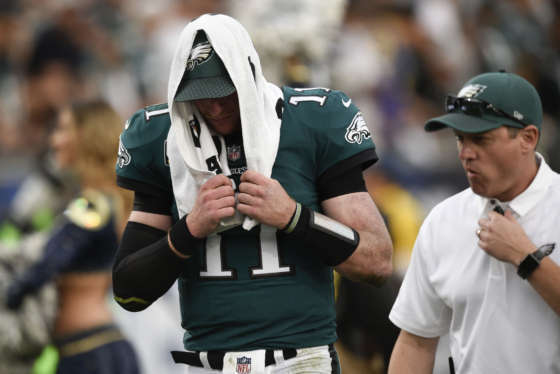WASHINGTON — Both of Pennsylvania’s NFL teams clinched their respective divisions on Sunday, but only one of those victories came with a massive caveat.
The Philadelphia Eagles were flying high at 10-2 when they migrated west to face the 9-3 Los Angeles Rams for a game that would be one of the most entertaining and competitive contests of Week 14 and figure prominently in the NFC playoff picture.
Then it all came crashing down in the third quarter.
Philly won the 43-35 shootout, but prized second-year quarterback Carson Wentz — one of the top candidates for league MVP — scrambled and dove into a pair of tacklers for an Eagles touchdown on a 1st-and-goal at the Rams’ 2-yard line. The play was nullified by a holding penalty, an apt microcosm of Philly’s season considering Wentz suffered a torn ACL on the play and is now officially out for the season.
It’s the latest in a breathtakingly long list of Pro Bowl-caliber players to suffer season-ending injuries in 2017. On a day when the Houston Texans inexplicably kept Tom Savage in their lineup after a hard hit and scary aftermath (a decision rightfully under investigation), the Eagles left Wentz on the field for four more plays after the goal line hit. On 4th-and-goal, Wentz hit Alshon Jeffery for a 2-yard touchdown that would be his last of the year.
I discussed the hit with our digital sports editor Noah Frank, and we both immediately drew parallels between the Wentz hit and the now-famous hit former Redskins QB Robert Griffin III took against the Baltimore Ravens in December 2012. Almost to the day, both former No. 2 overall picks took hits to the leg on a scramble, both men saw their legs bend awkwardly, and both men tried to press on and play anyway.
We’ve heard Griffin’s tale here in D.C. ad nauseam, so this really isn’t about that. It’s more about the notion that younger, mobile quarterbacks don’t know how to protect themselves properly and somehow get themselves in situations where these kinds of injuries can occur.
I don’t necessarily buy that. Few QBs run as much as Cam Newton or Russell Wilson and neither has had an injury end their season early (in fact, the smaller-than-average Wilson has yet to miss a game in his six NFL seasons despite 559 career rushing attempts). As I’ve pointed out in years past, less-than-mobile QBs such as Tom Brady and Peyton Manning have each suffered season-ending injuries despite staying in the pocket as prescribed.
The difference between the Wentz injury and the one suffered by RG3 is that Wentz was laying out to get a touchdown in a key conference game of immense importance. Though Griffin was also playing an important game (you may recall the ‘Skins started 3-6 that year and needed to win out to make the playoffs), it was a 2nd-and-long play where he should have slid feet first a couple yards sooner so he wouldn’t take a direct shot from 340-pound Haloti Ngata.
Regardless, Wentz got up and walked gingerly back to the huddle. If you saw the ensuing plays, Wentz barely moved. He looked like a statue on his passing attempts and even the two hand-offs to Corey Clement looked stiff. Hell, you could even see his leg buckle slightly at one point. Coach Doug Pederson or any trainer on that sideline should have noticed Wentz’s struggles and pulled him out immediately.
Sound familiar? It should remind Redskins fans of the cries to get an obviously limping RG3 off the painted dirt also known as FedEx Field. The turf was in better shape in LA, but Wentz should thank the football gods Aaron Donald or Robert Quinn didn’t come close to blowing out any more of his knee ligaments. As crestfallen as Philadelphia already was, this tale could have taken an even darker turn — one we’ve already seen play out with Griffin.
NFL teams have to do a better job of protecting their players. The league’s concussion protocol needs a serious overhaul (yes, I’m again referencing the abhorrent situation with Savage that’s played out not once, but twice in Houston) and frankly, there needs to be a system in place to ensure all injuries are appropriately diagnosed and treated before a player returns to the field. The blue tents are cute and all, but perhaps requiring a player to go to the locker room for a full evaluation is a better step toward progress.
This needs to be a high priority topic during the NFL offseason when a large batch of the best football players on the planet get healthy enough to start making their return to the gridiron. If not, many of those stars may find themselves in a similar situation in 2018.
Now make the updated NFL Week 14 Recap your priority.









